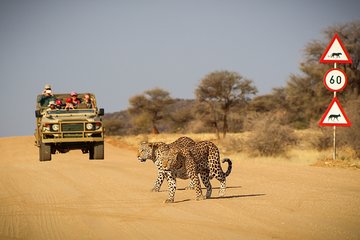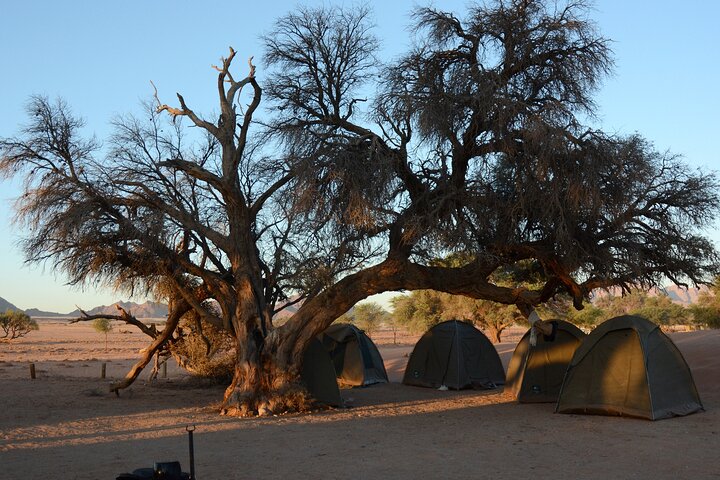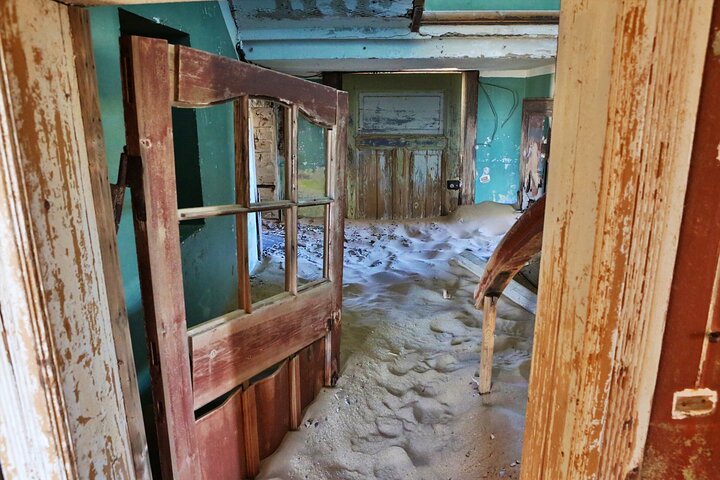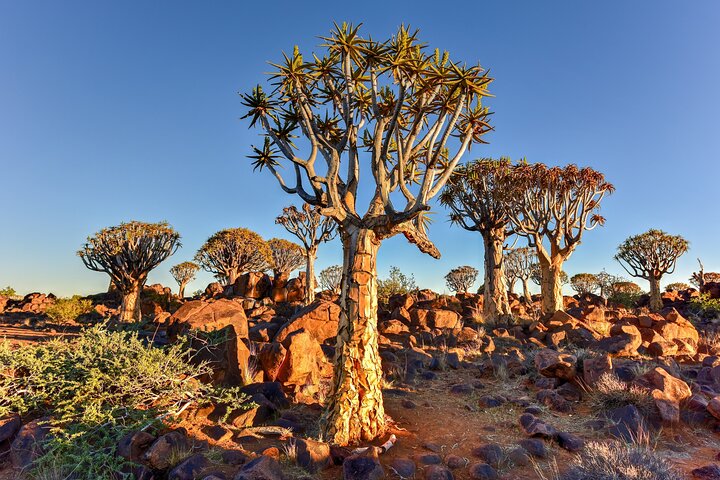12 Day Classic Namibia Camping Safari
Share this tour

Offered languages
- English
This 12 day tour is the perfect overview of Namibia’s highlights. Enjoy sightings of wildlife at the Okonjima Nature Reserve and Etosha National Park before immersing ourselves into the rich culture of the Himba tribe. We explore Namibia’s Skeleton Coast and visit the seals at Cape Cross before taking a short break from camping in Swakopmund, Namibia’s adventure capital. Here we can enjoy any number of adrenaline inducing optional activities before starting our journey south. Our next stop after crossing the Tropic of Capricorn is Sossusvlei in the Namib Desert, home to some of the world’s highest sand dunes. Continuing on to Namibia’s deep south with breath taking landscapes abound, we visit the ghost town of Kolmanskop, spot the wild horses of the Namib Desert, gaze over the Fish River Canyon, before ending an incredible 12 day trip with the last night at the impressive Quiver Tree Forest before returning to Windhoek. This is the ultimate Namibian adventure for the budget traveller!
What's Included
Lunch
Dinner
Breakfast
Meeting and pickup
Meeting point is in the lounge at Chameleon Safaris Headquarters
Itinerary
-
1Chameleon Safaris
We meet all together for brief pre-departure talk at Chameleon Safaris Headquarters before departing Windhoek.
45 minutes • Admission ticket free -
2Okahandja Mbangura Woodcarvers Craft Market
We stop briefly at the Okahandja Wood carving markets. Woodcarvers from all over Namibia, who practice their ancient skill, come here to sell their goods. This is the perfect opportunity to practice your haggling skills all while supporting the local community.
1 hour • Admission ticket free -
3
Our next stop is Mount Etjo Game Reserve, whose mission has been to make significant contributions to conservation, at the same time trying to ensure the survival of Namibia’s black and white Rhinos in their natural habit. We aim to arrive at camp before lunch, giving us ample time to set up camp and enjoy lunch before we join the afternoon activity. This afternoon you have a game drive on the reserve looking for some of the rhinos that were saved by the hard work of Mount Etjo Rhino Trust. We end our, afternoon game drive on the reserve while enjoying a Namibian sunset.
18 hours • Admission ticket free -
4
We depart from camp after a leisurely breakfast and stop briefly at Otjiwarongo, a small town north of Mount Etjo to gather some fresh supplies, before continuing on to Etosha National Park, one of Southern Africa’s premier wildlife areas.
30 minutes • Admission ticket free -
5Etosha National Park
Upon entering the gate, we start our search for wildlife. We enjoy a short game drive through to Okaukuejo, where we set up our camp and enjoy a delicious lunch, before heading out on an afternoon game drive. Etosha is unlike any other, and our game drives take us from waterhole to waterhole in search of predators as well as plains game, birds and if we are lucky, even reptiles. We return to camp just before sunset, and whilst dinner is cooking, we have the chance to visit the excellent floodlit waterhole where rhino, elephant, giraffe, lion and hyena are frequent visitors. Dinner is prepared by our guide over an open fire.
1 day • Admission ticket free -
6Etosha Pan
We start our first game drive at sunrise, to catch many of the predators still active, visiting various waterholes, making our way across the park, where we enjoy breakfast at one of the (fenced) picnic spots within the park. After breakfast we continue our journey arriving at the Etosha Pan “great white place” where we can get out of the vehicle and experience this 4500 sq km “saline desert” before continuing our game drive to look for the Big 4.
3 hours • Admission ticket included -
7
We make our way across the park to Halali, the central camp, where we can take a dip in the pool, visit the waterhole and enjoy lunch.
2 hours • Admission ticket included -
8Okaukuejo
After lunch we game drive back to Okaukuejo camp, visiting many waterholes, arriving at camp by sunset. Enjoy our last night camping in Etosha, and a visit to the waterhole after dinner is highly recommended.
12 hours • Admission ticket free -
9Etosha National Park
Another early start where we can take in a spectacular sunrise whilst having breakfast and enjoy a final game drive as we exit the park.
1 hour • Admission ticket free -
10
After a short drive we arrive in the small town of Kamanjab, where we stop to visit the Otjikandero Himba Village. The Himba people are one of the last tribes in Namibia who still embrace their traditional culture and customs and during a guided tour around the village we will have the chance to not only gain an in-depth insight into the Himba way of life, but to get to know the Himba people to share a little of our own culture with them.
2 hours • Admission ticket included -
11
After our visit to the Himba village, we continue to the Palmwag Campsite. Here we set up camp and enjoying a leisurely afternoon watching out for Desert Elephants. Dinner is prepared by our guide over an open fire.
12 hours • Admission ticket free -
12
Today our adventure today takes us all the way to the Atlantic Ocean and our final destination at Cape Cross. We travel westwards through to the Skeleton Coast, where we enter the Skeleton Coast National Park. The coast line itself is a very hostile but a fascinating area known for its numerous shipwrecks over the years, all victims of the thick fog, unpredictable currents and rough seas.
8 hours • Admission ticket free -
13
We arrive at Cape Cross mid-afternoon. The reserve is home to one of the world’s largest breeding colony of Cape fur seals and during breeding season (November-December) up to a 200 000+ seals can be spotted basking on the beach, certainly a sight and smell to behold.
1 hour • Admission ticket included -
14
Known as the “Matterhorn of Namibia,” Spitzkoppe is a breathtaking granite mountain range rising dramatically from the desert floor. Camping here offers a unique experience under vast star-filled skies, surrounded by striking rock formations. The campsites are rustic but well-situated, blending naturally into the landscape, with stunning sunrise and sunset views. It’s an ideal spot for photography, stargazing, hiking, and soaking in Namibia’s raw natural beauty.
12 hours • Admission ticket included -
15
We pack up camp, enjoy breakfast overlooking Spitzkoppe raw beauty and heading back to the coast.
1 hour • Admission ticket included -
16Zeila Shipwreck
We continue travelling back to the coast, stopping to view the Zeila Shipwreck, one of the latest victims of the Skeleton Coast from as recent as 2007.
30 minutes • Admission ticket free -
17Swakopmund
We arrive in Swakopmund early afternoon and have plenty of time to explore this quaint little town on foot, or join some of the optional activities on offer from skydiving to quad biking and more. Dinner tonight is at own expense in one of Swakopmund’s excellent restaurants and our guide will be happy to make recommendations or bookings depending on what we feel like.
18 hours • Admission ticket free -
18Swakopmund
Today we leave Swakopmund at 11h30 so we have the option to enjoy a rare sleep in and a leisurely breakfast or the chance to join one of the many optional activities. For the adrenaline junkies this could be flying down a sand dune head first at 60km/h on a sandboard or exploring the dune field on a quad biking tour.
4 hours • Admission ticket free -
19Solitaire
We depart Swakopmund no later than 11h30 and drive through the Namib Desert via the Kuiseb Pass, crossing the Tropic of Capricorn, stopping briefly in Solitaire where we can stop for a snack and leg stretch.
30 minutes • Admission ticket free -
20Sesriem
We arrive at our camp late afternoon where we can set up our tents, and enjoy the sunset over the Namib Desert. Pool and bar available, and dinner is prepared by our guide. An early night is recommended.
14 hours • Admission ticket free -
21Dune 45
A pre-dawn departure from camp this morning means we can enjoy the dunes at first light. We drive down an ancient river bed, surrounded by towering dunes and our first stop is at the famous Dune 45 where we have the chance to climb to the top to enjoy the sunrise. On descent we replenish our energy and enjoy breakfast.
2 hours • Admission ticket included -
22Sossusvlei
We continue on into Sossusvlei area. We explore this unique are on foot.
1 hour • Admission ticket free -
23Deadvlei
We then head into Dead Vlei with its large expanse of bleached cracked clay and skeletal camel thorn trees, contrasting with a backdrop of huge dunes with their ever changing colours.
2 hours • Admission ticket included -
24Sesriem
We return to Sesriem around lunch time for lunch and a swim or siesta during the heat of the day.
3 hours • Admission ticket free -
25Sesriem Canyon
Later that afternoon we visit the Sesriem Canyon, a must see when in the area.
1 hour • Admission ticket included -
26Sesriem
We pack up camp this morning and then enjoy a leisurely breakfast before starting our journey through the southern Namib Desert.
1 hour • Admission ticket free -
27
Today we head south through Namibia’s Namib Rand Nature Reserve, home to some of the most spectacular desert landscapes in Southern Namibia. Our destination today is the small outpost of Klein Aus, nestled in the Gondwana Sperrgebiet Rand Park. We arrive at Geisterschlucht Cabin late afternoon and we can set up our tents and then have the afternoon at leisure to enjoy one of the many short hiking trails. We enjoy a beautiful sunset and dinner prepared by our guide over an open-fire.
18 hours • Admission ticket included -
28
After an early breakfast we make our way from Klein Aus to the ghost town, also known as Kolmanskop, situated 15km outside of Luderitz. During a diamond boom in 1910 Kolmanskop quickly became one of the richest towns in Africa boasting the southern hemisphere’s first X-ray machine, a bowling alley and luxury housing. As the diamond boom came to an end and the town’s inhabitants abandoned the area, Kolmanskop became a ghost town.
3 hours • Admission ticket included -
29
After our tour of the ghost town, we continue our adventure to the small town of Luderitz, situated on the rocky shores of the Atlantic Ocean and is well known for its unique and colourful colonial-style buildings.
1 hour • Admission ticket free -
30
We stop at Diaz Point, the famous site of the Original Diaz Cross.
30 minutes • Admission ticket free -
31
On return to Aus, we keep our eyes peeled for the wild horses of the Namib Desert that roam between Luderitz & Klein Aus. While the details of how these horses came to live in the desert are still a mystery, the mere fact that they have survived in the harshest of conditions is impressive, and any sighting of them is one to celebrate.
30 minutes • Admission ticket free -
32
We arrive back at camp late mid-afternoon and can relax for the afternoon before enjoying another incredible sunset over the Aus Mountains. Dinner tonight is prepared by our guide.
18 hours • Admission ticket included -
33
We enjoy an another early start this morning as we pack up camp and head east. Our first official stop is at the well-known Hell`s Bend viewpoint of the Fish River Canyon. Here we have the opportunity to overlook the second largest canyon in the world. The Fish River Canyon was formed millions of years ago by water erosion and the collapse of the valley due to movements in the earth’s crust.
1 hour • Admission ticket included -
34
After lunch we continue our adventure heading to our last destination; The Quiver Tree Forest. It is located just north-east of Keetmanshoop and here approximately 250 quiver trees can be found. The forest grew spontaneously and the oldest trees are estimated to be around 200-300 years old. The quiver tree (kokerboom in Afrikaans) is also Namibia’s national tree, The last night on our adventure is spent camping under the stars with meals prepared by our guide. This is an excellent location for photographing the stars should you be an avid photographer (permits not included for night photography).
12 hours • Admission ticket included -
35
We start the day exploring the Quiver Tree at Sunrise and then take on the long journey back to Windhoek. Have a picnic-style lunch en- route.
1 hour • Admission ticket not included -
36Windhoek
From here, we begin our journey back to Windhoek travelling the small towns of Mariental and Rehoboth before arriving in Windhoek late afternoon where we will be dropped off at our accommodation. No flights recommended on this day.
30 minutes • Admission ticket free
Mount Etjo Game Reserve
Etosha National Park
Etosha National Park
Palmwag Campsite, Kunene Region
Spitzkoppe Damaraland
Swakopmund on the Skeleton Coast
Namib Desert
Sossusvlei in the Namib Desert
Klein Aus Vista, Namib Desert
Kolmanskop & Luderitz
Fish River Canyon & Quiver Tree Forest
Windhoek
Additional info
- Public transportation options are available nearby
- Not recommended for travelers with spinal injuries
- Not recommended for pregnant travelers
- Not recommended for travelers with poor cardiovascular health
- Travelers should have at least a moderate level of physical fitness
Tags
Cancellation Policy
All sales are final. No refund is available for cancellations.
Show more
Cancellation Policy
This experience is non-refundable and cannot be changed for any reason. If you cancel or ask for an amendment, the amount you paid will not be refunded.
Rating
You will not receive a refund if you cancel.
Your guide to the flawless travel experience











